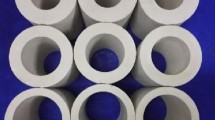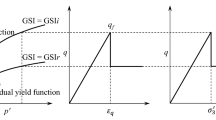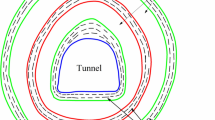Abstract
A broken zone usually exists in the deeply buried tunnels after excavation, and the rock mass in the broken zone is in the state of unloading failure and exhibiting a nonlinear dilatancy effect. In order to study the deformation of isotropic rock mass in an initial hydrostatic stress field, a method is proposed to calculate the radius of the broken zone of the surrounding rock in a circular tunnel. Based on the unloading experiment of rock samples, a layer-wise summation method is established to calculate the displacement of the circular tunnel after excavation. The results reflect the impact of the nonlinear dilatancy effect on the displacement of the tunnel wall along the radial direction. Moreover, the method does not include complex integral calculation. Comparing with the Kastner’s (Houska 1981) method and Y K Lee’s (Lee and Pietruszczak 2008) method. This article reveals that the residual strength parameters cr, φr and dilation angle ψ, that are essential in Y K Lee’s method, are highly sensitive to displacement calculation, which makes the Y K Lee’s method difficult to apply. In contrast, the method proposed in this study provides accurate prediction and has access to obtain its parameters more easily, making it easy to popularize.



















Similar content being viewed by others
References
Alonso E, Alejano LR, Varas F, Fdez-Manin G, Carranza-Torres C (2003) Ground response curves for rock masses exhibiting strain-softening behaviour. Int J Numer Anal Methods Geomech 27:1153–1185. https://doi.org/10.1002/nag.315
Brady BHG, Brown ET (2006) Rock mechanics for underground mining: Third edition
Brown ET, Bray JW, Ladanyi B, Hoek E (1983) Ground response curves for rock tunnels. J Geotech Eng 109:15–39. https://doi.org/10.1061/(ASCE)0733-9410(1983)109:1(15)
Cai M, Kaiser PK, Tasaka Y, Minami M (2007) Determination of residual strength parameters of jointed rock masses using the GSI system. Int J Rock Mech Min Sci. 44:247–265. https://doi.org/10.1016/j.ijrmms.2006.07.005
Cui L, Zh J, Zhang RDY (2015)Elasto-plastic analysis of a circular opening in rock mass with confining stress-dependent strain-softening behaviour. Tunn Undergr Sp Technol 50:94–108
Duncan Fama ME, Trueman R, Craig MS (1995)Two- and three-dimensional elasto-plastic analysis for coal pillar design and its application to highwall mining. Int J Rock Mech Min Sci. 32:215–225. https://doi.org/10.1016/0148-9062(94)00045-5
Fang Q, Zhang D, Zhou P, Wong LNY (2013) Ground reaction curves for deep circular tunnels considering the effect of ground reinforcement. Int J Rock Mech Min Sci 60:401–412. https://doi.org/10.1016/j.ijrmms.2013.01.003
Ghorbani A, Hasanzadehshooiili H (2019) A comprehensive solution for the calculation of ground reaction curve in the crown and sidewalls of circular tunnels in the elastic-plastic-EDZ rock mass considering strain softening. Tunn Undergr Sp Technol 84:413–431. https://doi.org/10.1016/j.tust.2018.11.045
Guan Z, Jiang Y, Tanabasi Y (2007) Ground reaction analyses in conventional tunnelling excavation. Tunn Undergr Sp Technol 22:230–237. https://doi.org/10.1016/j.tust.2006.06.004
Han J, Li S, Li S, Yang W (2013a) A procedure of strain-softening model for elasto-plastic analysis of a circular opening considering elasto-plastic coupling. Tunn Undergr Sp Technol 37:128–134. https://doi.org/10.1016/J.TUST.2013.04.001
Han JX, Li SC, Li SC, Yang WM (2013b) A procedure of strain-softening model for elasto-plastic analysis of a circular opening considering elasto-plastic coupling. Tunn Undergr Sp Technol. 37:128–134. https://doi.org/10.1016/j.tust.2013.04.001
Houska J (1981) Fundamentals of rock mechanics, Engineerin. Engineering Geology
Huang X, Liu Q, Liu B, Liu X, Pan Y, Liu J (2017) Experimental study on the dilatancy and fracturing behavior of soft rock under unloading conditions. Int J Civ Eng 15:921–948. https://doi.org/10.1007/s40999-016-0144-9
Lee YK, Pietruszczak S (2008) A new numerical procedure for elasto-plastic analysis of a circular opening excavated in a strain-softening rock mass. Tunn Undergr Sp Technol 23:588–599. https://doi.org/10.1016/j.tust.2007.11.002
Medhurst TP, Reed K (2005) Ground response curves for longwall support assessment. Min Technol 114:81–88. https://doi.org/10.1179/037178405X44575
Obert LI, Duvall W (1967) Rock mechanics and design of structures in rock. Spec Tech Publ
Park KH, Kim YJ (2006) Analytical solution for a circular opening in an elastic-brittle-plastic rock. Int J Rock Mech Min Sci 43:616–622. https://doi.org/10.1016/j.ijrmms.2005.11.004
Park KH, Tontavanich B, Lee JG (2008) A simple procedure for ground response curve of circular tunnel in elastic-strain softening rock masses. Tunn Undergr Sp Technol 23:151–159. https://doi.org/10.1016/j.tust.2007.03.002
Sharan SK (2003)Elastic-brittle-plastic analysis of circular openings in Hoek-Brown media. Int J Rock Mech Min Sci 40:817–824. https://doi.org/10.1016/S1365-1609(03)00040-6
Sharan SK (2005) Exact and approximate solutions for displacements around circular openings in elastic-brittle-plasticHoek-Brown rock. Int J Rock Mech Min Sci 42:542–549. https://doi.org/10.1016/j.ijrmms.2005.03.019
Singh A, Seshagiri Rao K, Ayothiraman R (2019) A closed-form analytical solution for circular opening in rocks using Drucker–Prager criterion. Indian Geotech J 49:437–454. https://doi.org/10.1007/s40098-019-00358-6
Vitali OPM, Celestino TB, Bobet A (2020) Analytical solution for a deep circular tunnel in anisotropic ground and anisotropic geostatic stresses. Rock Mech Rock Eng 53:3859–3884. https://doi.org/10.1007/s00603-020-02157-5
Wang F, Qian D (2018) Difference solution for a circular tunnel excavated in strain-softening rock mass considering decayed confinement. Tunn Undergr Sp Technol 82:66–81. https://doi.org/10.1016/j.tust.2018.08.001
Wang S, Yin X, Tang H, Ge X (2010) A new approach for analyzing circular tunnel in strain-softening rock masses. Int J Rock Mech Min Sci 47:170–178. https://doi.org/10.1016/j.ijrmms.2009.02.011
Wang S, Zheng H, Li C, Ge X (2011) A finite element implementation of strain-softening rock mass. Int J Rock Mech Min Sci 48:67–76. https://doi.org/10.1016/j.ijrmms.2010.11.001
Zareifard MR (2019) Ground response curve of deep circular tunnel in rock mass exhibiting Hoek-Brown strain-softening behaviour considering the dead weight loading. Eur J Environ Civ Eng:1–31
Zareifard MR, Fahimifar A (2016) Analytical solutions for the stresses and deformations of deep tunnels in an elastic-brittle-plastic rock mass considering the damaged zone. Tunn Undergr Sp Technol 58:186–196. https://doi.org/10.1016/j.tust.2016.05.007
Zhang Q, Jiang B, Lv H (2016) Analytical solution for a circular opening in a rock mass obeying a three-stagestress–strain curve. Int J Rock Mech Min Sci 86:16–22. https://doi.org/10.1016/j.ijrmms.2016.03.013
Zhang Q, Jiang BS, Lin WS et al (2012)Elasto-plastic analysis of a circular opening in strain-softening rock mass. Int J Rock Mech Min Sci 50:38–46. https://doi.org/10.1016/j.ijrmms.2011.11.011
Zou JF, Li C, Wang F (2017) A new procedure for ground response curve (GRC) in strain-softening surrounding rock. Comput Geotech 89:81–91. https://doi.org/10.1016/j.compgeo.2017.04.009
Funding
This work has been supported by the National Natural Science Foundation of China (Key Program, Grant No.41830110); the China Postdoctoral Science Foundation (Grant No. 2015M571656); China Communications Maintenance Group 2020 major scientific and technological research and development projects (27100020Y248, 27100020Y251, 27100020Y249); The Science and Technology Project of Jiangsu Province Construction System (Grant No. 2017ZD090); and The Science and Technology Project of Zhejiang Provincial Water Resources Department (Grant No. RA1503).
Author information
Authors and Affiliations
Contributions
Conceptualization, Caihua Shen and Wenbo Gu; methodology, Caihua Shen and Wenbo Gu; Software, Wenbo Gu; validation, Caihua Shen and Wenbo Gu; formal analysis, Wenbo Gu; investigation, Wenbo Gu; Resources, Caihua Shen; data curation, Wenbo Gu; writing–original draft preparation, Wenbo Gu; writing–review & editing, Caihua Shen; visualization, Wenbo Gu; supervision, Caihua Shen.
Corresponding author
Ethics declarations
Conflict of interest
The authors declares no competing interests.
Additional information
Responsible editor: Zeynal Abiddin Erguler
Appendix
Appendix
The Y, N, B, and C in this paper are defined respectively,
List of symbols
bradius of a tunnel
p0 initial stress in a rock mass before the excavation is made
c, φrock mass cohesion, angle of internal friction of the rock mass
E, νYoung’s modulus, Poisson’s ratio
G shear modulus of rock mass
γ (kN/m3)weight of rock mass
Hdepth of tunnel
σ1axial pressure in triaxial compression test
σ2confining pressure in triaxial compression test
σθhoop stress
σrradial stress
εθtangential strain
εrradial strain
εvvolume strain
pisupport pressure
picsupport pressure for the occurrence of broken zone
riith layer’s radius
hithe thickness of the ith layer
kicoefficient of dilation in ith layer
Rpradius of the plastic zone
Rcradius of the broken zone
cr residual cohesion
φrresidual friction angle
ψdilation angle
uiradial displacement at r = ri
uB radial displacement of the elasto-plastic interface
uC radial displacement of the plastic-broken interface
Rights and permissions
About this article
Cite this article
Shen, C., Gu, W. An improved analytical approach for analyzing a circular opening excavated in a strain-softening rock mass. Arab J Geosci 14, 2050 (2021). https://doi.org/10.1007/s12517-021-08402-7
Received:
Accepted:
Published:
DOI: https://doi.org/10.1007/s12517-021-08402-7




